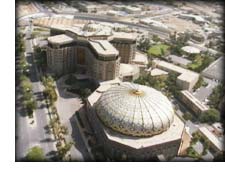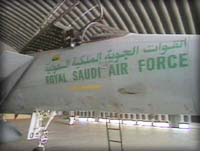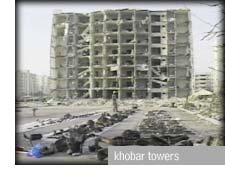 |  |  |
| 1932 |  | Modern kingdom of Saudi Arabia founded |
|
 King Abdel Aziz ibn Saud unified the kingdom of Saudi Arabia following a
series of military conquests between 1902 and 1926. He established an absolute
monarchy, which gained legitimacy from an 18th century alliance between the Al
Saud family and the Wahhabi sect of Islam. Muhammed bin Abd al-Wahhab, the
founder of Wahhabism, preached a strict adherence to the principles of sharia
(Islamic law). His relationship with a
local chieftain of the Al Saud family contributed to the strengthening and
endurance of both the Wahhabis' religious authority, and the Al Sauds'
political authority.
King Abdel Aziz ibn Saud unified the kingdom of Saudi Arabia following a
series of military conquests between 1902 and 1926. He established an absolute
monarchy, which gained legitimacy from an 18th century alliance between the Al
Saud family and the Wahhabi sect of Islam. Muhammed bin Abd al-Wahhab, the
founder of Wahhabism, preached a strict adherence to the principles of sharia
(Islamic law). His relationship with a
local chieftain of the Al Saud family contributed to the strengthening and
endurance of both the Wahhabis' religious authority, and the Al Sauds'
political authority.
Saudi Arabia and the United States established diplomatic relations in 1933.
|
 |
| 1933 |  | Saudi Arabia and Standard Oil sign concession agreement |
|
King Abdel Aziz granted a concession to the U.S. company, Standard Oil, which
allowed them to explore for oil in the country's Eastern Province. The joint
enterprise eventually became known as the Arabian American Oil Company
(Aramco). The company granted a loan of £50,000 to the Saudi government
and paid it other assorted rental fees and royalty payments. In exchange, Aramco received exclusive rights to mine, produce and export oil from the
eastern part of the country, free of Saudi taxes and duties. In 1938, efforts
were rewarded with the first discovery of commercial quantities of oil at
Dammam Well Number 7, located near Dhahran.
The agreement was modified several times over the years. In 1950, Saudi Arabia
and Aramco agreed to a 50-50 profit-sharing arrangement, and a series of
agreements between 1973 and 1980 resulted in the Saudis' regaining full control
of the company. In 1988, King Fahd issued a royal decree establishing the Saudi
Arabian Oil Company, known as Saudi Aramco, to replace Aramco.
|
 |
1940-
1945 |  | Saudi Arabia gains strategic importance during World War II |
|
Although Saudi Arabia officially maintained neutrality through most of the war,
the U.S. began to court the kingdom as it realized the strategic importance of
Saudi oil reserves. In 1943, President Franklin Roosevelt made Saudi Arabia
eligible for Lend-Lease assistance by declaring the defense of Saudi Arabia of
vital interest to the U.S. In 1945, King Abdel Aziz and President Roosevelt
cemented the tacit oil-for-security relationship when they met aboard the USS
Quincy in the Suez Canal.
|
 |
| 1951 |  | U.S. and Saudi Arabia formalize security relationship |
|
Under a mutual defense agreement, the U.S. established a permanent U.S.
Military Training Mission in the kingdom and agreed to provide training support
in the use of weapons and other security-related services to the Saudi armed
forces. The U.S. Army Corps of Engineers assisted in the construction of
military installations in the kingdom. This agreement formed the basis of what
grew into a longstanding security relationship.
|
 |
| 1953 |  | Crown Prince Saud becomes king |
|
Upon his death, King Abdel Aziz was succeeded by his son, Crown Prince Saud,
who was known for his reputation as a spendthrift. Under King Saud, the
kingdom's treasury diminished rapidly and he was forced to turn over direct
control of government affairs to his half-brother Faisal from 1958 to 1961. In
1964, the royal family and religious leadership forced Saud to abdicate in
favor of Faisal.
|
 |
| 1960 |  | OPEC is founded |
|
At a conference in Baghdad, Saudi Arabia joined Iran, Iraq, Kuwait and
Venezuela in founding the Organization of Petroleum Exporting Countries (OPEC).
The organization -- which was later joined by Qatar, Indonesia, Libya, United
Arab Emirates, Algeria and Nigeria -- was established to coordinate and unify
petroleum production and pricing among the member nations.
|
 |
| 1963 |  | U.S. fighter jets sent to Saudi Arabia |
|
The 1962-1967 civil war in Yemen pitted Saudi-supported royalists against
Egyptian-supported republicans. In November 1963, Egyptian aircraft bombed
several villages inside Saudi territory. U.S. President John F. Kennedy
responded by sending a squadron of F-100 fighter jets to protect Saudi Arabia.
The Egyptians backed down after the threat from the U.S., but tensions between
the two nations did not subside until Egypt withdrew its troops from Yemen in
1967.
|
 |
| 1964 |  | Faisal becomes king |
|
 Upon his accession to the throne, King Faisal began a modernization program,
which stressed economic development and included increased expenditures for
education. Partly because of his reputation as a pious Muslim, King Faisal was
able to cautiously introduce Western technology as part of his modernization
efforts, including the kingdom's first television broadcasts in 1965. The
introduction of television offended some Saudis, including one of the king's
nephews, who was killed in a police shootout after he lead an assault on one of
the new television stations. Upon his accession to the throne, King Faisal began a modernization program,
which stressed economic development and included increased expenditures for
education. Partly because of his reputation as a pious Muslim, King Faisal was
able to cautiously introduce Western technology as part of his modernization
efforts, including the kingdom's first television broadcasts in 1965. The
introduction of television offended some Saudis, including one of the king's
nephews, who was killed in a police shootout after he lead an assault on one of
the new television stations.
|
 |
1974-
1985 |  | Saudi Arabia develops infrastructure during oil boom
years |
|
Petroleum prices rose during the 1970s and early 1980s, and the Saudi economy
became one of the fastest-growing world economies. By 1981, oil revenues in the
kingdom had reached $116 billion per year.
The explosion of petrodollars into the Saudi economy led to a rapid
infrastructure development during the government's First Five Year Development
Plan (1970-75) and Second Five Year Development Plan (1975-80). The nation
rapidly increased its pipeline capacity, seaports, and telecommunication
structure. The government also invested large sums of money in building new
airports, hotels, schools, hospitals and power plants, and tripled the total
length of paved highways. Many foreign private firms invested in joint
ventures to build refineries and other technologies important to the
petrochemical industry. During the Third Five-Year Development Plan (1980-1985), the government targeted spending on social services, education and healthcare.
The petrodollars were also used to fund the construction of new mosques and
religious schools, known as madrassas, throughout the kingdom and abroad. There
was an explosion in religious charities that were funded by a newly wealthy
citizenry. U.S. officials believe that the network of madrassas across the
world -- funded by the Saudi charities and fueled by the strict Wahhabi
interpretation of Islam -- evolved into a network of recruiting schools that
were to train Islamic militants to fight the jihad war in Afghanistan against
the Soviet invasion (1979-1989).
|
 |
| 1975 |  | King Faisal assassinated |
|
On March 25, King Faisal was shot and killed by a disgruntled nephew -- the
brother of the king's nephew who had been killed in the 1965 shootout at the
television station. The king's assassin was executed after an investigation
showed he had acted alone.
King Faisal was succeeded by Crown Prince Khalid, whose reign was marked by
continued modernization efforts and a more influential role for Saudi Arabia in regional
politics.
|
 |
Mar.
1979 |  | Saudi Arabia breaks off diplomatic relations with Egypt |
|
Outraged by the Egypt-Israeli Camp David peace treaty, King Khalid broke off
relations with Egypt. Diplomatic relations were not restored until November
1987.
|
 |
Nov.
1979 |  | The monarchy faces internal political dissent |
|
Surprising many who believed fundamentalism was not a strong force in Saudi
Arabia, Sunni Islamic dissidents seized control of the Grand Mosque at Mecca,
one of the holiest sites in Islam. The armed dissidents charged that the Al
Saud regime had lost its legitimacy due to corruption and its closer ties to
Western nations. The standoff lasted for several weeks before the Saudi
military succeeded in removing the dissidents. More than 200 troops and
dissidents were killed at the mosque, and subsequently over 60 dissidents were
publicly beheaded.
Two weeks later the monarchy faced riots in the Eastern Province by Shi'a
Muslims inspired by Ayatollah Khomeini's victory in Iran. The government sent
20,000 troops to the area. Several protesters were killed and hundreds were
reportedly arrested. In the wake of the riots, the government announced
economic development projects for the region to improve the standard of living
in Shi'a areas.
|
 |
| 1979 |  | U.S. military sales to Saudi Arabia |
|
In the wake of Ayatollah Khomeini's revolution in Iran and the Soviet Union's
invasion of Afghanistan, the U.S. and Saudi Arabia continued to strengthen
their security relationship. The continuing explosion of petrodollars into the
Saudi treasury allowed the government to increase military expenditures. Since
1979, the kingdom has spent more than $50 billion on U.S. military purchases,
including 5 airborne warning and control systems (AWACS) and a $5.6 billion
"peace shield" -- a state of the art command and control system for the Royal
Saudi Air Force with six underground command centers linking 147
defense-related sites.
 In the U.S., arms sales to Saudi Arabia often faced strong congressional
opposition because of fears that the arming of Saudi Arabia would threaten Israel. In 1985, Congress
rejected President Reagan's proposed sale of an arms package to Saudi Arabia
that included 42 F-15s, antiaircraft missiles, Harpoon antiship missiles, and
Blackhawk helicopters, and Reagan was forced to withdraw the proposal. In 1986 and
1988, Congress approved scaled-down arms packages that included Bradley
fighting vehicles, TOW II antitank missiles, electronic upgrades for the F-15s,
and 12 replacement F-15s that would remain in the U.S. until they were needed
by the Saudis. The Stinger antiaircraft and Maverick antitank missiles were
deleted from the president's earlier request.
|
 |
| 1981 |  | Formation of Gulf Cooperation Council |
|
Saudi Arabia joined five other Persian Gulf nations -- Bahrain, Kuwait, Oman,
Qatar, and the United Arab Emirates -- in forming the Gulf Cooperation Council
(GCC), an economic and political policy-coordinating forum. At the time, the
six countries contained more than half the world's oil resources.
|
 |
Jun.
1982 |  | King Fahd assumes the throne |
|
After a short illness, King Khalid died and was succeeded by Crown Prince Fahd.
King Fahd faced decreased oil revenues due to declining global oil prices
in the late 1980s and 1990s. However, under King Fahd, Saudi Arabia continued to maintain
its influence in the Arab world, with the king serving as a mediator in both
the Lebanese civil war and the Iran-Iraq conflict that was resolved in 1988.
King Fahd maintained healthy relations with the United States.
|
 |
1990-
1991 |  | Persian Gulf War |
|
Saudi Arabia and the United States were close allies during the crisis and war that
followed the surprise Iraqi invasion of Kuwait on August 2, 1990. As Iraqi
combat forces moved toward the Saudi border, King Fahd authorized the
deployment of U.S. forces to aid in his border defense.
The kingdom hosted over 600,000 allied forces, and its treasury reached record
deficit levels in 1990 and 1991. The U.S. spent $60 billion on the Gulf War,
with the Saudis and Kuwaitis footing half the bill. As a
result, the Saudi government was forced to borrow from commercial banks and
export credit agencies for the first time.
Approximately 5,000 U.S. troops have remained in the kingdom since the Gulf
War. Their presence has served as a major grievance for fundamentalist critics
of the regime, including Saudi-born Osama bin Laden.
|
 |
| 1992 |  | Religious leaders criticize King Fahd |
|
A group of 107 Wahhabi religious figures sent a 46-page "Memorandum of Advice"
to King Fahd, which criticized the government for corruption and human-rights
abuses and for allowing U.S. troops on Saudi soil. The document advocated that
the government follow a stricter adherence to sharia and repudiate relations
with non-Western governments. King Fahd dismissed seven of the seventeen
members of the country's highest clerical body, the Supreme Authority of Senior
Scholars, for refusing to denounce the memorandum.
|
 |
| 1994 |  | Monarchy faces protests in Buraida |
|
Prompted by the government's arrest of two dissident Wahhabi clerics for
anti-government preaching, several thousand protestors staged demonstrations in
the Saudi town of Buraida. The clerics had accused the monarchy of corruption
and of betraying Islam by allowing U.S. troops on the Saudi peninsula. While
the government admitted it arrested over 100 protestors, opposition groups
claimed thousands were arrested after the demonstrations.
The incident forced the government to cede more control to the Wahhabi clerics,
but only with the promise of their support. The clerics were quietly released
from prison in 1999.
|
 |
Nov.
1995 |  | Terrorist bombing in Riyadh kills five Americans |
|
In the first terrorist attack against U.S. troops on Saudi soil, five Americans
were killed when a bomb exploded at a U.S.-operated Saudi National Guard
training center in Riyadh.
The Saudi government arrested four Saudi men in connection with the bombing and
coerced them into a public confession. In the confession, they claimed to have been
inspired by bin Laden communiqués. Although bin Laden denied
involvement, he praised the attack. Before the FBI had a chance to interview
the suspects, they were beheaded in Riyadh's main square.
|
 |
Nov.
1995 |  | King Fahd suffers a stroke |
|
Since suffering the stroke, King Fahd's health has continued to decline. By the
end of 1997, Crown Prince Abdullah had become the de facto leader of the
country and assumed many of the day-to-day responsibilities of running the
government.
In contrast to King Fahd, who was seen as a staunch U.S. ally, Crown Prince
Abdullah is known for his support of Arab and Islamic causes, particularly his
strong support of the Palestinian intifada. He has criticized the U.S. for not
opposing Israeli violence in Palestine, turning down a May 2001 invitation to
visit the White House.
|
 |
Jun.
1996 |  | Khobar Towers bombing kills 19 U.S. servicemen |
|
 A large truck bomb devastated the U.S. military residence in Dhahran, called
Khobar Towers, killing 19 servicemen. Again, U.S. law-enforcement efforts to
investigate the bombing were met with resistance by Saudi officials. In June
2001, a federal grand jury indicted 13 Saudis and one Lebanese man for the
attack. As of mid-November 2001, Saudi Arabia has ruled out the idea of any
extraditions.
A large truck bomb devastated the U.S. military residence in Dhahran, called
Khobar Towers, killing 19 servicemen. Again, U.S. law-enforcement efforts to
investigate the bombing were met with resistance by Saudi officials. In June
2001, a federal grand jury indicted 13 Saudis and one Lebanese man for the
attack. As of mid-November 2001, Saudi Arabia has ruled out the idea of any
extraditions.
|
 |
| 1997 |  | Saudi Arabia recognizes the Taliban |
|
In September 1996, the Taliban gained control of the Afghan city of Kabul. The
following year, Saudi Arabia became one of only three countries to establish
diplomatic relations with the Taliban. The Taliban are followers of the Deobandi school of Islam, an extreme form of the faith closely related to Wahhabism. Although diplomatic ties were not
broken until after the Sept. 11 terrorist attacks, relations were scaled back
in 1998 after the kingdom accused the Taliban of harboring Osama bin Laden.
On Sept. 25, 2001, the kingdom broke relations with the Taliban and issued a
statement that said: "It is to be regretted that the government of the Taliban
made use of Afghanistan's special status, not to build up brotherly relations
or set up high Islamic values, but to make its land a center to attract and
train a number of misguided people of all nationalities, and in particular,
from among the citizens of the Kingdom of Saudi Arabia, in order to carry out
criminal acts that are against every tenet of Shariah [Islamic Law] and faith:
moreover, Taliban has continued to refuse to hand those criminals over to
justice."
|
 |
Aug.
2001 |  | Strains in U.S.-Saudi relationship |
|
Frustrated by the lack of U.S. response to Israeli-Palestinian violence, Crown
Prince Abdullah sent President George W. Bush an angry letter on August 29, according to an October 2001 report in The Wall Street Journal. He
warned that Saudi Arabia was being put in an untenable position and reportedly
wrote: "A time comes when peoples and nations part. We are at a crossroads. It
is time for the United States and Saudi Arabia to look at their separate
interests. Those governments that don't feel the pulse of their people and
respond to it will suffer the fate of the Shah of Iran."
|
 |
Sep. 11,
2001 |  | Saudi response to terrorist attacks |
|
 Saudi Arabia issued a statement on the day of the terrorist attacks on the
World Trade Center and the Pentagon, calling them "regrettable and inhuman." As
of mid-November, the Bush administration has continued to publicly praise Saudi
support for the war on terrorism.
Saudi Arabia issued a statement on the day of the terrorist attacks on the
World Trade Center and the Pentagon, calling them "regrettable and inhuman." As
of mid-November, the Bush administration has continued to publicly praise Saudi
support for the war on terrorism.
However, published media reports have indicated U.S. frustration with Saudi
inaction. Although 15 of the 19 Sept. 11 hijackers were Saudi nationals, publicly the Saudis were not cooperating with Americans wanting to look at background files of the hijackers or interview the hijackers' families. Although the U.S.
might have wanted to use Saudi bases for its campaign in Afghanistan, the U.S.
knew it couldn't ask the Saudis to allow American planes to fly bombing raids
against the Taliban.
|
 |

